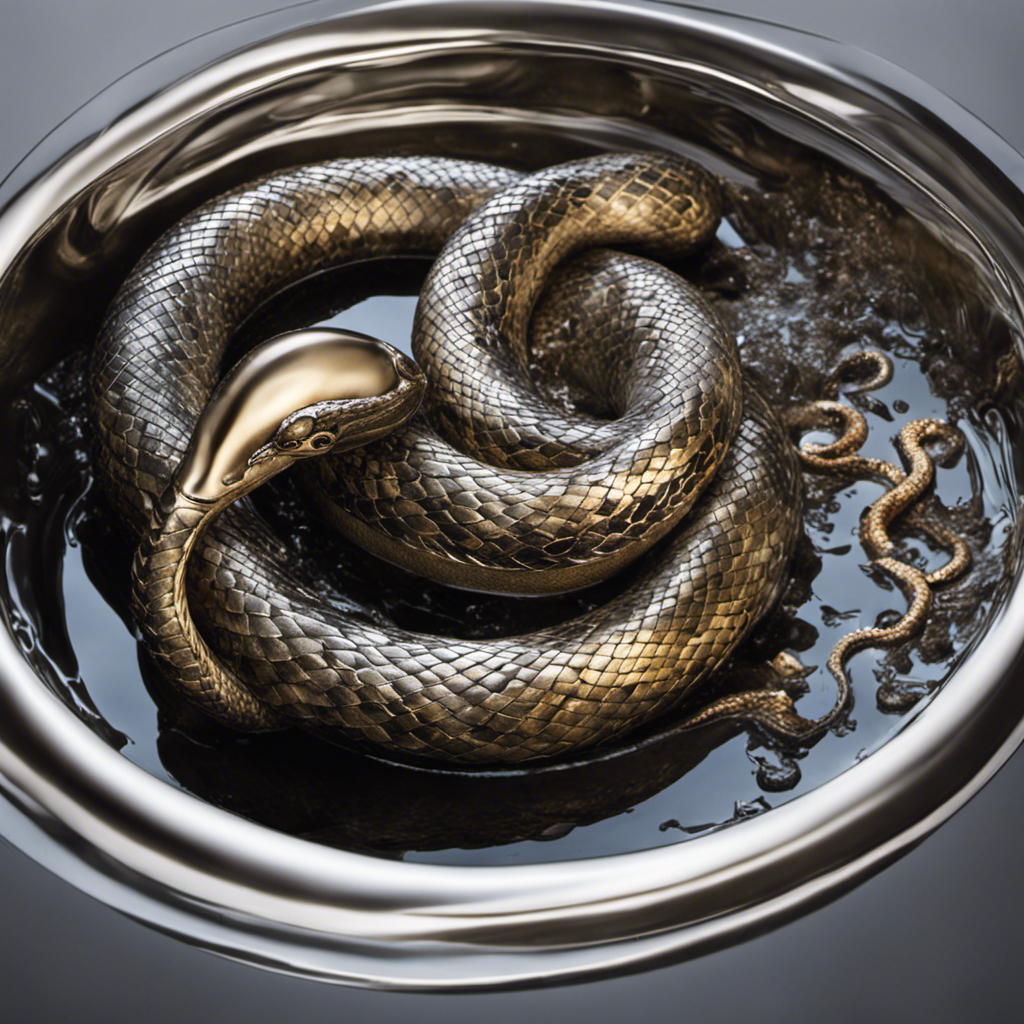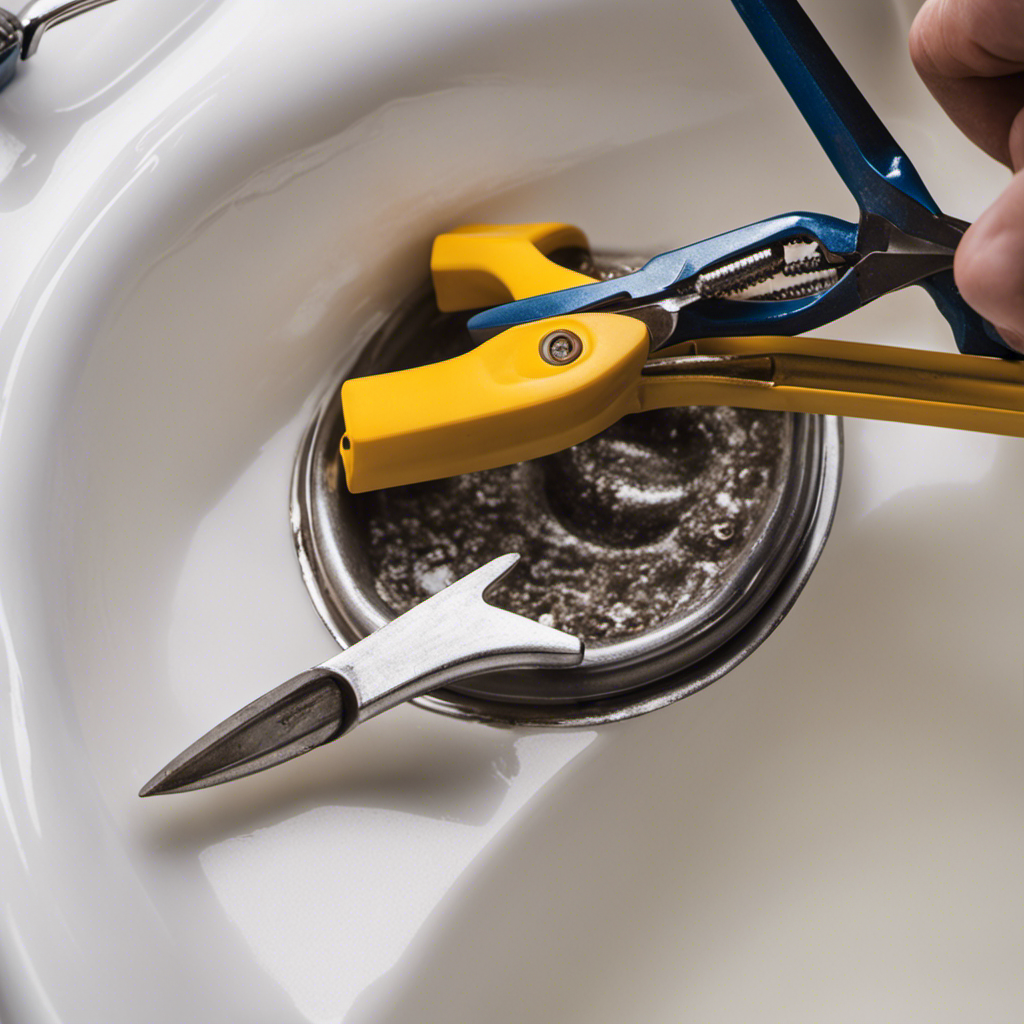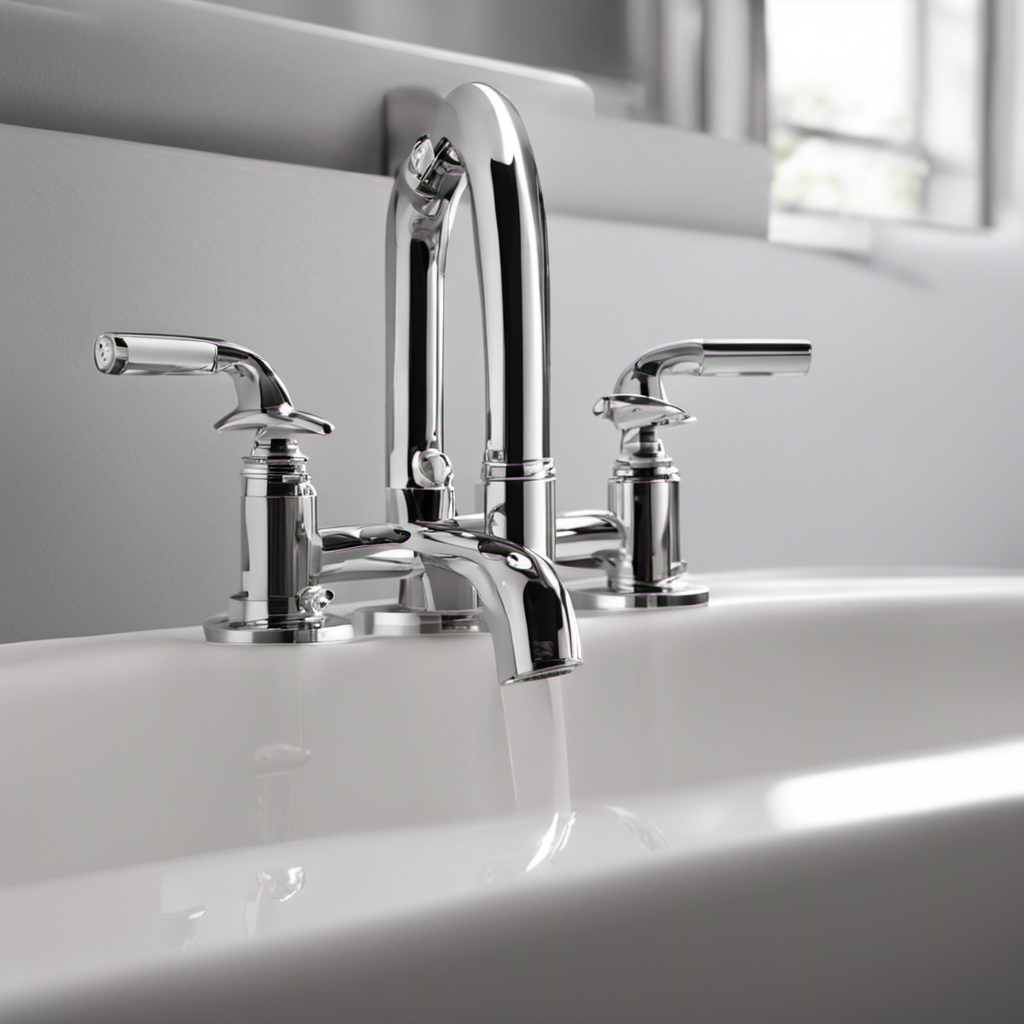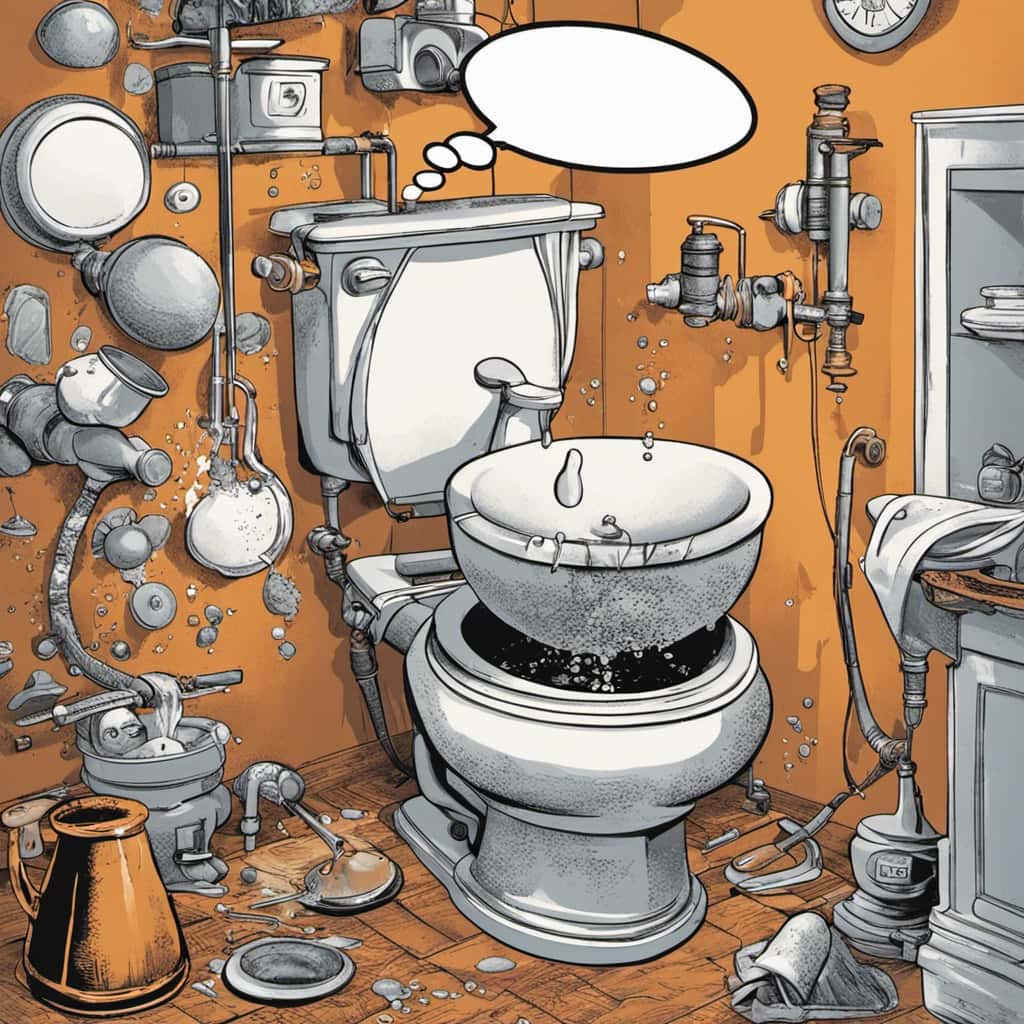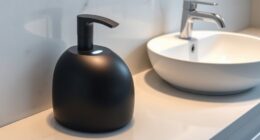I’ve been there before – standing ankle-deep in water, frustrated by a clogged bathtub drain. But fear not, because I’ve discovered the secret to restoring proper drainage: snaking the drain.
In this article, I’ll guide you through the step-by-step process of snaking a bathtub drain, ensuring you can tackle this plumbing challenge with confidence.
So grab your tools, prepare your bathroom, and let’s dive into the world of drain snaking to bring back the flow your bathtub deserves.
Key Takeaways
- The drain snake is a long, flexible tool used for clearing clogs in a bathtub drain.
- Rotating the drain snake clockwise helps break up stubborn clogs.
- Patience and persistence are important while snaking the drain.
- Regular preventative maintenance, such as using drain covers and cleaning the bathroom regularly, can help prevent clogs in the bathtub drain.
Understanding the Anatomy of a Bathtub Drain
First, you’ll want to understand the anatomy of your bathtub drain.
The bathtub drain consists of several components that work together to facilitate the flow of water.
The first component is the drain flange, which is the visible part of the drain that you see when you look at the bathtub. It is usually made of metal and is screwed onto the drain pipe.
The drain pipe is a long, cylindrical tube that connects the drain flange to the main plumbing system.
Inside the drain pipe is the stopper mechanism, which can be opened or closed to control the flow of water.
When it comes to removing clogs from the bathtub drain, there are several common techniques that you can try.
These include using a plunger, using a drain snake, or using a chemical drain cleaner.
Each technique has its own advantages and disadvantages, so it’s important to choose the right one for your situation.
Gathering the Necessary Tools and Materials
To start, you’ll need a pair of gloves and a bucket to collect any debris.
Clearing blockages in a bathtub drain can be a common and frustrating issue. However, with the right tools and troubleshooting methods, you can easily tackle the problem.
First, put on your gloves to protect your hands from any potential mess. Then, grab a bucket to catch any debris that may come out during the process.
It’s important to gather these materials beforehand to ensure a smooth and efficient clearing process. By having a pair of gloves and a bucket ready, you’ll be prepared to tackle any blockage that may be causing your bathtub drain to clog.
Preparing the Bathroom for Drain Snaking
Before I can begin snaking the bathtub drain, there are a few important steps I need to take in order to prepare the bathroom.
First, I need to clear away any clutter that may be in the way, such as shampoo bottles or bath toys.
Next, I will need to remove the drain cover, which can usually be done by unscrewing it or lifting it up with a screwdriver.
Clearing Bathroom Clutter
Get rid of all the unnecessary items cluttering your bathroom. Clearing bathroom clutter is an essential step in organizing bathroom storage. By decluttering, you can create a more functional and visually appealing space. Start by going through each item in your bathroom and deciding if it’s necessary or not. Use the table below as a guide to help you categorize your items:
| Category | Keep | Donate | Toss |
|---|---|---|---|
| Toiletries | Toothbrush | Expired | Empty |
| Toothpaste | Unused | Old | |
| Soap | |||
| Shampoo | |||
| Conditioner | |||
| Lotion | |||
| Makeup | |||
| Towels | Good | Worn | Torn |
| Condition | |||
Once you have sorted your items, find suitable storage solutions for each category. Use bins, shelves, and organizers to keep everything in its place. Remember to regularly declutter and reorganize your bathroom to maintain a clean and organized space.
Removing Drain Cover
Removing the drain cover can be easily done with a screwdriver. Here’s how:
-
Identify the anatomy of the drain cover: Most drain covers consist of a flat metal plate with small holes or slots for water to flow through. They are typically held in place by screws or a locking mechanism.
-
Locate the screws or locking mechanism: Look for screws around the perimeter of the drain cover. If there are no screws, the cover might have a locking mechanism that needs to be released by twisting or lifting.
-
Use a screwdriver to remove the screws or unlock the mechanism: Insert the screwdriver into the screw heads and turn counterclockwise to loosen and remove the screws. If there is a locking mechanism, follow the manufacturer’s instructions to release it.
Removing stubborn drain covers may require additional tools or techniques, such as using a plunger or applying lubricant. Always exercise caution and refer to professional help if needed.
Gathering Necessary Tools
Make sure you have all the necessary tools ready for the task at hand. Understanding drain blockages and having the right tools is essential for effectively cleaning your bathtub drain.
There are several common drain cleaning methods that you can choose from, depending on the severity of the clog. One option is using a plunger to create pressure and force the clog out. Another method is pouring a mixture of baking soda and vinegar down the drain to break down the debris. For more stubborn blockages, a drain snake or auger can be used to physically remove the clog.
These tools are readily available at most hardware stores and can be a lifesaver when it comes to dealing with drain issues. Now that you understand the different methods, let’s move on to removing the bathtub drain cover.
Removing the Bathtub Drain Cover
When it comes to removing the bathtub drain cover, there are a few key points to keep in mind.
First, understanding the different types of drain covers is crucial, as they may require different removal methods.
Second, having the right tools for removal is essential, such as a screwdriver or pliers.
Lastly, it is important to take safety precautions during the process, such as wearing gloves and ensuring the area is well-lit to avoid accidents.
Types of Drain Covers
To identify the types of drain covers in your bathtub, take a look at the different designs and materials used. Here are three common types of drain covers and the pros and cons of each:
-
Metal drain covers: These covers are durable and can withstand heavy use. However, they may rust over time and require regular maintenance to prevent corrosion.
-
Plastic drain covers: These covers are lightweight and easy to clean. They are also less likely to rust or corrode. However, they may not be as durable as metal covers and can crack or break under pressure.
-
Tile-in drain covers: These covers are designed to blend in with the surrounding tile, creating a seamless look. They offer a stylish and customized appearance. However, they can be more difficult to clean and may require professional installation.
Knowing the different types of drain covers will help you choose the best option for your bathtub.
Now, let’s explore the tools needed for removing these covers.
Tools for Removal
One tool you’ll need for removing drain covers is a screwdriver. It’s a versatile tool that can help you tackle common drain problems with ease.
When it comes to removing drain covers, a flathead screwdriver is often the most useful. The flat, narrow tip allows you to slide it under the edges of the drain cover and gently pry it up.
However, for some drain covers that have screws holding them in place, a Phillips screwdriver may be required.
Additionally, a pair of pliers can come in handy if the drain cover is stuck or difficult to remove.
Safety Precautions Required
Now that we know about the tools needed for removing a clog from a bathtub drain, let’s talk about the safety precautions required to prevent accidents during the process.
It’s essential to prioritize safety to avoid any injuries or mishaps. Here are some important safety measures to keep in mind:
-
Protective Gear: Always wear protective gear such as gloves and safety goggles to shield yourself from any potential harm. This will help protect your hands from chemical cleaners and your eyes from any debris that may splash.
-
Proper Ventilation: Ensure that the bathroom is well-ventilated by opening windows or using a fan. This will help prevent the buildup of harmful fumes from chemical cleaners.
-
Secure the Area: Clear the area around the bathtub, removing any tripping hazards or objects that could cause accidents. Make sure to have a stable footing to avoid slipping during the process.
Inserting the Drain Snake Into the Drain
Gently push the drain snake into the bathtub drain, making sure it goes in smoothly. To understand drain snakes better, it’s important to know that they are long, flexible tools used for clearing clogs in drains. They have a coiled metal wire with sharp edges that grab onto debris and pull it out. Here’s a table to help you visualize the process:
| Step | Action | Description |
|---|---|---|
| 1 | Insert Drain Snake | Gently push the drain snake into the bathtub drain, ensuring it goes in smoothly. |
| 2 | Rotate and Push | Rotate the handle while pushing the snake further into the drain. |
| 3 | Feel Resistance | If you encounter resistance, you’ve reached the clog. |
| 4 | Break Up and Remove the Clog | Continue rotating and pushing to break up and remove the clog. |
| 5 | Retrieve the Drain Snake | Slowly pull out the drain snake, ensuring it doesn’t get stuck or tangle. |
Once you’ve inserted the drain snake, the next step is to snake the bathtub drain and break up the clog, which we’ll cover in the next section.
Snaking the Bathtub Drain and Breaking up the Clog
After inserting the drain snake, it’s time to break up the clog in the bathtub drain. Here are three effective drain snaking techniques to help you clear the blockage:
-
Rotate the snake: Start by turning the handle of the drain snake clockwise. This will help the auger at the end of the snake break up the clog and grab onto it.
-
Push and pull: Gently push the snake further into the drain while maintaining a firm grip on the handle. Once you feel resistance, pull the snake back out. This back-and-forth motion helps dislodge the clog and bring it to the surface.
-
Twist and turn: As you continue snaking the drain, try twisting the snake in different directions. This twisting motion can help break up stubborn clogs and clear the pipe more effectively.
Remember to be patient and persistent while snaking the drain. With these techniques, you’ll be able to effectively break up clogs and restore the proper flow of water in your bathtub drain.
Retracting the Drain Snake and Removing the Debris
To remove the debris, carefully retract the drain snake and dispose of the clog. The retracting technique is crucial to ensure that all the accumulated debris is effectively cleared from the bathtub drain.
After breaking up the clog with the drain snake, slowly pull it out while rotating it clockwise. This motion helps to dislodge any remaining debris and ensures a thorough cleaning.
Once the drain snake is completely removed, it is important to dispose of the clog properly. I recommend placing the clog in a garbage bag or wrapping it in newspaper before throwing it away. This prevents any potential mess or unpleasant odors.
With the debris disposed of, we can now proceed to the next step: flushing the drain and testing for proper flow.
Flushing the Drain and Testing for Proper Flow
Now, it’s time to flush the drain and check if the water flows properly. Testing the drain after snaking it is crucial to ensure that the clog has been completely cleared.
Here are some methods to test for proper flow and signs of a clogged drain:
-
Run hot water: Turn on the hot water faucet and let it flow for a few minutes. If the water drains smoothly without any backups or slow draining, it indicates that the drain is clear.
-
Test with a small amount of water: Pour a small amount of water down the drain and observe how it drains. If it flows freely without any gurgling sounds or slow draining, it signifies that the clog has been successfully removed.
-
Check for odors: A foul odor coming from the drain even after snaking may indicate a lingering clog or buildup. If you notice any unpleasant smells, it might be necessary to repeat the snaking process or seek professional assistance.
Preventative Maintenance Tips for a Clear Bathtub Drain
Regularly cleaning your bathroom and using a drain strainer can help prevent future clogs in your bathtub.
Proper bathtub drain maintenance is essential to keep the water flowing smoothly and prevent any potential blockages.
One important step is to clean the drain regularly by removing any hair, soap scum, or debris that may have accumulated.
Using a drain strainer is also highly recommended as it can catch hair and other particles before they go down the drain and cause a clog.
Additionally, it is important to avoid pouring any grease, oils, or harsh chemicals down the drain, as they can build up and lead to blockages.
Troubleshooting Common Issues and Next Steps
When it comes to dealing with a clogged drain, it’s important to understand the causes behind it to effectively address the issue.
Some common causes of clogged drains include the accumulation of hair, soap scum, grease, and food particles.
To effectively clean a clogged drain, one can use methods such as using a plunger, a drain snake, or a mixture of baking soda and vinegar to break down the clog and restore the flow of water.
Clogged Drain Causes
To figure out what’s causing your clogged bathtub drain, start by checking for hair and soap build-up. Hair is one of the primary culprits for clogged drains, easily accumulating over time and forming a blockage. To prevent this, use a drain cover or strainer to catch hair before it goes down the drain.
Soap build-up is another common cause, especially if you have hard water. Soap scum can accumulate in the drain pipes, hindering water flow and leading to clogs. Regularly cleaning the drain with hot water and vinegar can help prevent soap build-up.
Foreign objects can also cause blockages if accidentally dropped down the drain. Items like jewelry, small toys, or cotton swabs should be kept away from the drain to avoid potential clogs.
Now that you know the causes of clogged drains, let’s move on to effective drain cleaning methods.
Effective Drain Cleaning
One effective method for cleaning drains is using a mixture of baking soda and vinegar. This combination creates a chemical reaction that can help break down clogs and clear out your pipes.
To use this method, start by pouring boiling water down the drain to help loosen any debris. Then, pour about half a cup of baking soda followed by half a cup of vinegar into the drain. Cover the drain with a cloth or stopper to keep the mixture contained and let it sit for about 30 minutes.
Frequently Asked Questions
How Long Does It Usually Take to Snake a Bathtub Drain?
On average, snaking a bathtub drain takes around 30 minutes. To troubleshoot, start by removing the overflow plate and using a drain snake to clear any clogs. Be sure to follow safety precautions and consult a professional if needed.
Can I Use a Regular Household Plunger Instead of a Drain Snake?
I wouldn’t recommend using a regular plunger instead of a drain snake. While it’s an alternative method, a plunger doesn’t have the same benefits as a drain snake for clearing clogs in a bathtub drain.
Are There Any Specific Safety Precautions I Should Take Before Snaking a Bathtub Drain?
Before snaking a bathtub drain, it’s crucial to take safety precautions. Wear gloves and goggles to protect yourself from any debris or chemicals. Additionally, make sure you have the necessary tools, such as a drain snake, to effectively clear the clog.
Is There a Certain Type of Drain Snake That Works Best for Bathtub Drains?
There isn’t a certain type of drain snake that works best for bathtub drains. Different types of drain snakes are used for different types of clogs. Using a drain snake has benefits over other unclogging methods.
What Should I Do if Snaking the Drain Doesn’t Fix the Clog?
If snaking the drain doesn’t fix the clog, there are alternative clog removal methods to try. You can use a plunger, a drain cleaner, or a mixture of baking soda and vinegar. If all else fails, it’s time to call a professional plumber.
Conclusion
In conclusion, snaking a bathtub drain is a simple and effective way to keep your drain clear and prevent clogs. By understanding the anatomy of the drain and gathering the necessary tools, you can easily remove debris and restore proper flow.
Remember to take preventative measures and perform regular maintenance to avoid future issues. With a little effort and the right technique, you can enjoy a smoothly flowing bathtub drain and avoid any unpleasant surprises.
Happy snaking!
